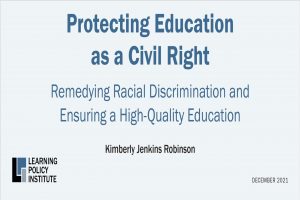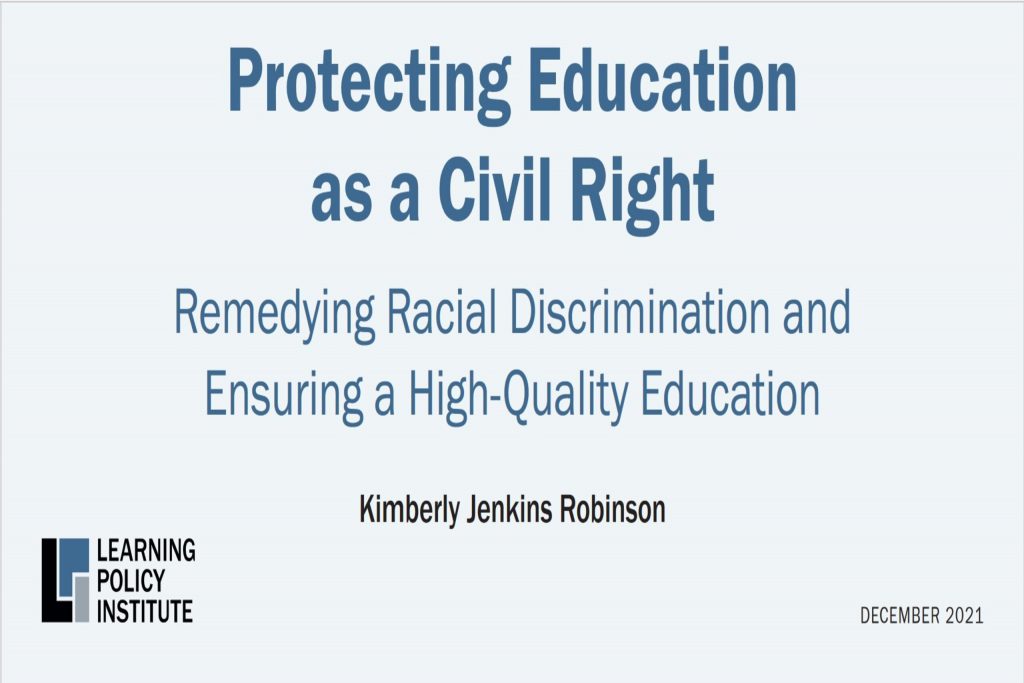Protecting Education as a Civil Right: Remedying Racial Discrimination and Ensuring a High-Quality Education

Education has long stood at the epicenter of the battle for civil rights. More than half a century after the U.S. Supreme Court declared racially segregated schools unlawful in Brown v. Board of Education, educational opportunity and achievement gaps based on race, national origin, class, and neighborhood have endured. These disparities harm important national interests such as a knowledgeable and engaged citizenry, a robust economy, a well-prepared military, and a just society. As schools are resegregating at alarming rates, protecting education as a civil right is crucial for creating equitable and high-quality educational opportunities for students across the country.
Limited protection for education as a civil right at the federal level and uneven protection at the state level have contributed to persistent inequities in opportunity and achievement. Title VI of the Civil Rights Act of 1964, which prohibits discrimination on the basis of race, color, or national origin in any program or activity that receives federal financial assistance, has had significant historical impact but is limited in its ability to ensure nondiscrimination in public schools. A review of state law reveals that states vary widely in their legal protections from racial discrimination in education.
Civil rights provide protections from discrimination on the basis of such characteristics as race, color, sex, disability, national origin, sexual orientation, and religion. Civil rights also include affirmative rights to a body of law that protects the capacity of individuals to participate in society and flourish. This report acknowledges both definitions of civil rights in order to provide a comprehensive approach.
Guaranteeing and protecting education as a civil right can serve important goals, including providing a foundation to a thriving democracy, preparing schoolchildren to become productive members of our economy and society, reducing the societal costs of inadequate education, and remedying the fundamental injustice of low-quality and inequitable educational opportunities. Leaders across the political spectrum have framed education as a critical civil rights issue and confirmed the importance of equal educational opportunity. This consensus provides an important starting point for exploring the deeper questions surrounding what it means to protect education as a civil right in the United States as well as an opportunity to seize the current moment to address the effects of racial discrimination and inequity in education.
This report explores two critical questions. First, how do existing federal and state laws and policies protect, or fail to protect, education as a civil right? Second, how can federal and state laws and policies be reformed to protect education as a civil right? The report offers recommendations for complementary federal and state reforms that can better protect education as a civil right.
The Federal Role
To strengthen the protections from racial discrimination in education and enforcement of these protections, the federal government could:
- Raise awareness of discrimination in educational opportunities on the basis of race, national origin, and color.
- Amend Title VI of the Civil Rights Act of 1964 to prohibit disparate impact discrimination and provide a private right of action to enforce it.
- Increase technical assistance and grants to states and districts to support implementation of best practices for preventing and remedying disparate impact discrimination and providing greater access to equitable educational opportunities.
- Increase funding to Office for Civil Rights (OCR) and the Department of Justice’s Educational Opportunities Section to enforce Title VI’s disparate impact prohibition and other protections from racial discrimination.
- Issue OCR guidance clarifying the disparate impact legal standard to support stronger administrative and judicial enforcement.
The State Role
States can take the following steps to help address discrimination in education:
- Adopt a far-reaching prohibition of education discrimination that covers all types of discrimination and discrimination in all facets of education.
- Develop a definition of discrimination to cover disparate impact and unintentional discrimination
- Elevate the importance and durability of the state prohibitions of discrimination in education by adopting these prohibitions in state constitutions.
- Offer both technical and financial assistance to districts and schools to aid in their understanding and enforcement of these laws.
- Implement a comprehensive approach to enforcing both Title VI and state civil rights laws that includes expansion of state attorney general offices or state educational agencies with statutory enforcement authority.






